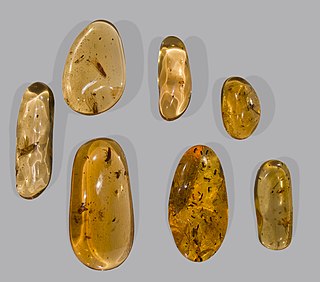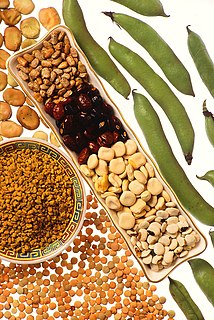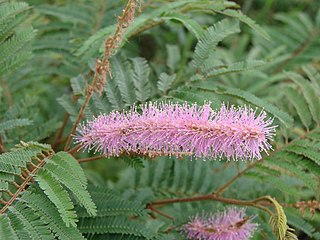
Mimosa is a genus of about 400 species of herbs and shrubs, in the mimosoid clade of the legume family Fabaceae. The generic name is derived from the Greek word μῖμος (mimos), an "actor" or "mime", and the feminine suffix -osa, "resembling", suggesting its 'sensitive leaves' which seem to 'mimic conscious life'.

In polymer chemistry and materials science, resin is a solid or highly viscous substance of plant or synthetic origin that is typically convertible into polymers. Resins are usually mixtures of organic compounds. This article focuses on naturally occurring resins.

The Fabaceae or Leguminosae, commonly known as the legume, pea, or bean family, are a large and economically important family of flowering plants. It includes trees, shrubs, and perennial or annual herbaceous plants, which are easily recognized by their fruit (legume) and their compound, stipulate leaves. Many legumes have characteristic flowers and fruits. The family is widely distributed, and is the third-largest land plant family in number of species, behind only the Orchidaceae and Asteraceae, with about 751 genera and about 19,000 known species. The five largest of the genera are Astragalus, Acacia, Indigofera, Crotalaria, and Mimosa, which constitute about a quarter of all legume species. The ca. 19,000 known legume species amount to about 7% of flowering plant species. Fabaceae is the most common family found in tropical rainforests and in dry forests in the Americas and Africa.

Copal is a name given to tree resin, particularly the aromatic resins from the copal tree Protium copal (Burseraceae) used by the cultures of pre-Columbian Mesoamerica as ceremonially burned incense and for other purposes. More generally, the term copal describes resinous substances in an intermediate stage of polymerization and hardening between "gummier" resins and amber.

A legume is a plant in the family Fabaceae, or the fruit or seed of such a plant. The seed is also called a pulse. Legumes are grown agriculturally, primarily for human consumption, for livestock forage and silage, and as soil-enhancing green manure. Well-known legumes include alfalfa, clover, beans, peas, chickpeas, lentils, lupins, mesquite, carob, soybeans, peanuts, and tamarind. Legumes produce a botanically unique type of fruit – a simple dry fruit that develops from a simple carpel and usually dehisces on two sides.

Cercis is a genus of about 10 species in the subfamily Cercidoideae of the pea family Fabaceae, native to warm temperate regions. It contains small deciduous trees or large shrubs commonly known as redbuds. They are characterised by simple, rounded to heart-shaped leaves and pinkish-red flowers borne in the early spring on bare leafless shoots, on both branches and trunk ("cauliflory"). Cercis is derived from the Greek word κερκις (kerkis) meaning "weaver's shuttle", which was applied by Theophrastus to C. siliquastrum.

Erythrina is a genus of flowering plants in the pea family, Fabaceae. It contains about 130 species, which are distributed in tropical and subtropical regions worldwide. They are trees, with the larger species growing up to 30 m (98 ft) in height. The generic name is derived from the Greek word ερυθρóς (erythros), meaning "red", referring to the flower color of certain species.

Albizia is a genus of more than 160 species of mostly fast-growing subtropical and tropical trees and shrubs in the subfamily Mimosoideae of the family Fabaceae. The genus is pantropical, occurring in Asia, Africa, Madagascar, America and Australia, but mostly in the Old World tropics. In some locations, some species are considered weeds.

Guibourtia is a flowering plant genus in the family Fabaceae, also known by the common names as Rhodesian teak, African rosewood, amazique, bubinga, kevazingo and ovangkol.

Hymenaea L. is a genus in the flowering plant family Fabaceae. Of fourteen living species in the genus, all but one are native to the tropics of the Americas, with one additional species on the east coast of Africa. Some authors place the African species in a separate monotypic genus, Trachylobium. In the Neotropics, Hymenaea is distributed through the Caribbean islands, and from southern Mexico to Brazil. Linnaeus named the genus in 1753 in Species Plantarum for Hymenaios, the Greek god of marriage ceremonies. The name is a reference to the paired leaflets.

Hymenaea courbaril is a tree common in the Caribbean, Central America, and South America. It is a hardwood that is used for furniture, flooring, and decoration. Its hard fruit pods have edible dry pulp surrounding the seeds. Its sap, called animé, is used for incense, perfume, and varnish.

Vachellia nilotica is a flowering plant tree in the family Fabaceae. It is native to Africa, the Middle East and the Indian subcontinent. It is also a Weed of National Significance in Australia as well as a Federal Noxious Weed in the United States.
Erythrina schliebenii is a species of legume in the family Fabaceae. It is found only in Tanzania. The species is named for German collector and botanist Hans-Joachim Schlieben.

Mimosa verrucosa, jurema-branca or jurema-de-oeiras is a species of legume in the common bean family, Fabaceae, and in the subfamily and genus of Mimosa pudica, the touch me not.

Dipteryx alata is a large, undomesticated, edible nut-bearing tree from dryish tropical lowlands in central South America belonging to the legume family, Fabaceae, from the Dipterygeae tribe in the Faboideae subfamily. It is a wild species, widespread across the Cerrado savanna in South America.
Copal tree may refer to several tree species:

Crotalaria verrucosa is a species of flowering plant in the legume family, Fabaceae. This shrub belongs to the subfamily Faboideae. The herb found in Bangladesh, China, Cambodia, India, Indonesia, Laos, Malaysia, Myanmar, Nepal, Philippines, Sri Lanka, Thailand, Vietnam; Australasia and Africa and Americas regions.

Genisteae is a tribe of trees, shrubs and herbaceous plants in the subfamily Faboideae of the legume family Fabaceae. It includes a number of well-known plants including broom, lupine (lupin), gorse and laburnum.

Hymenaea stiginocarpa is an irregularly shaped, mostly 6–9 m (20–30 ft) high tree that has been assigned to the pea family. It has a twisted spindle-shaped trunk, a very rough grey bark, and reddish-brown twigs. The deciduous leaves consist of two large asymmetrical leaflets with an entire margin. The flowers occur in clusters of up to thirty at the end of the branches. It produces edible, highly appreciated fruits, which are often collected from the wild and used by local people. The vernacular name of this species in Brazil is jatobá do cerrado.
Daniellia oliveri is a species of tree in the family Fabaceae. It is native to tropical West and Central Africa and is commonly known as the African copaiba balsam tree, or the West African copal tree.


















